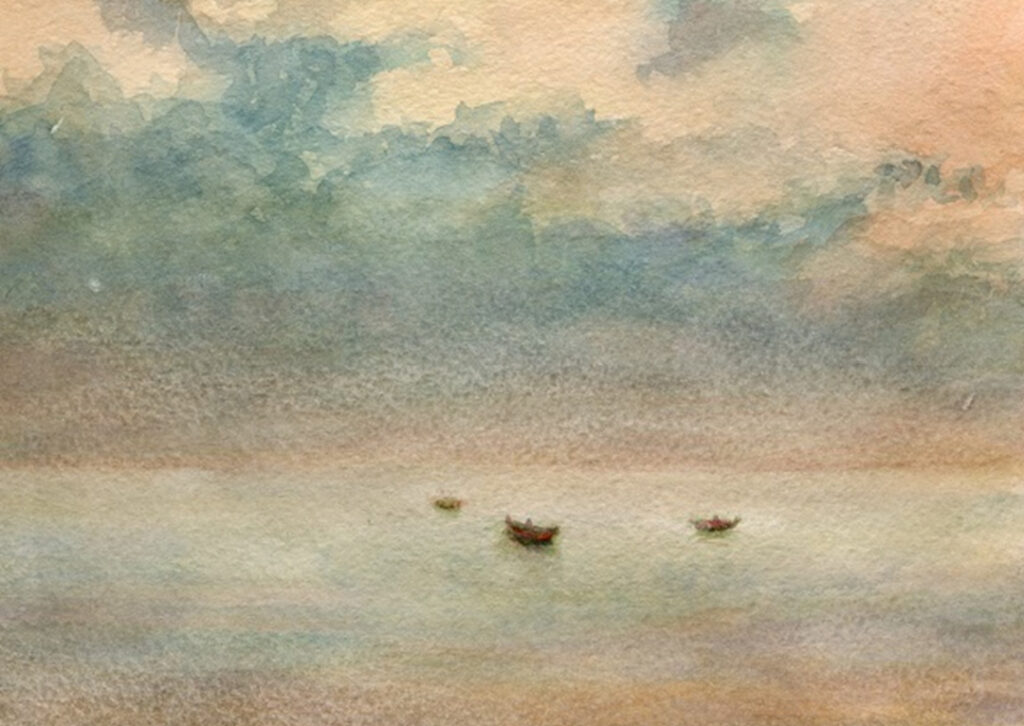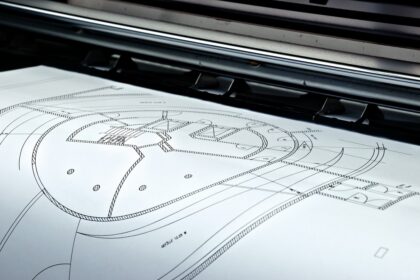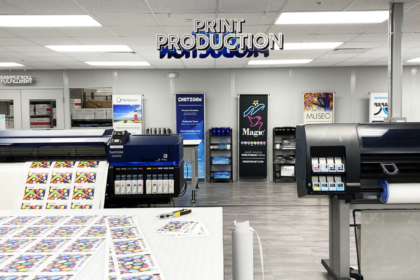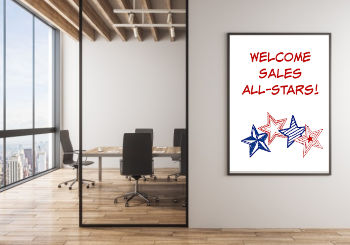Buying professional-quality inkjet art paper or inkjet photo paper is different than buying inkjet paper for technical drawings, short-term photographic displays, and everyday office printing. Sometimes, the terms used to describe inkjet art paper and inkjet photo paper products can be confusing.
But you should learn what these words mean because they describe specialized materials and surface treatments that improve the longevity, tactile appeal, and aesthetics of prints on inkjet art paper and inkjet photo paper.
Here are some of the most commonly used terms used with inkjet art paper and inkjet photo paper.
Inkjet art papers typically have surface textures that replicate the look and feel of traditional papers used for watercolor paintings or etchings from classic art printmaking tools.

Inkjet photo papers are designed to replicate classic darkroom papers. These papers have whiter, smoother surfaces for better reproduction of details.

A – G
Acid-free: A pH neutral paper manufactured without acid in the pulp. To be designated acid-free, the paper must have a pH between 6.5 and 7.5. Acids in paper can attack the paper fibers, causing the paper to become brittle deterioration over time.
Alpha cellulose: Cellulose is a substance in the cell walls of plants. A high alpha-cellulose is very pure form of wood pulp that can yield the same longevity as cotton or other plant fibers.
Anti-Curl Coating: A thin coating on the back of inkjet photo media to keep it flat after printing.
Archival: The term has different meanings in different contexts. An archival paper generally is one that is manufactured to meet standards established by the ISO (International Standards Organization), ASTM (American Society for Testing and Materials), or DIN (German Institute for Standardization). Archival prints are typically made with pigment inks on archival papers and handled, stored and displayed according to recommendations made by the Image Permanence Institute. (See: IPI Guide to Preservation of Digitally Printed Photographs)
Baryta: A special coating applied to the surface of an archival art paper to make it smoother and whiter for photographic printing. Baryta is a mixture of gelatin and the white pigment barium-sulfate. Because the back of a baryta inkjet paper isn’t coated with a plastic, the printed photo feels more like an art print on a fibrous art paper. Baryta photo papers for inkjet printing have microporous ink-receptive coatings for long-lasting pigment inks.
Brightness: A measure of the how much light is reflected from the surface of the sheet. The higher the percentage, the higher the brightness. A high brightness produces visual contrast between the printed and unprinted areas.
Buffered: Protected from acid in the paper or from airborne pollutants. Alkaline buffering agents (such as calcium carbonate or magnesium carbonate) are added to the paper pulp to neutralize acids. Acids can be caused by residual chlorine from bleaching operations, aluminum sulfate (alum) from paper sizing, or exposure sulfur dioxide in the atmosphere.
Caliper: The thickness of the paper measured in thousandths of an inch (mils).
Canvas: A woven cotton fabric commonly used for paintings. Inkjet canvas is typically made with a combination of polyester and cotton. Inkjet media with microporous ink-receptive surface coatings have enough water resistance to use water-based texturing gels or water-based protective clearcoats.
Canvas Paper: Cut sheets of canvas, or papers with a surface treatment that simulates the look of canvas.’
Coating: There are two types of coatings used with art and photo papers. An ink-receptive coating on the surface of the papers keeps the colors close to the surface for greater color accuracy and vibrancy. A protective coating applied after the inks have been applied to the paper can keep the inks safe from scratches, UV-light-induced fading, or airborne pollutants.
Cold Pressed: Papers that are pressed through cold cylinders to create a slight surface texture.
Cotton Rag: A high-quality paper made from cotton linters or a combination of cotton linters and cotton rags. Cotton linters are pure cellulose fibers from cotton processing. Rag fibers are longer fibers than cotton linters and provide extra strength. But papemakers have shifted aware from 100% cotton-rag papers because the rags became scarcer as textile producers shifted to polyester and other synthetic fabrics.
Deckle: The feathery edge that results from wet pulp when making hand-made or mould-made papers. A deckled edge can also be produced by tearing the sheets when they are wet.
Digital art: Artwork that was originally created on a computer or mobile device.
Dmax/Dmin: The Dmax is a densitometric measurement of the darkest black a paper can achieve with a given set of inks. On inkjet printers that can’t print white ink, the Dmin is the non-printed area of the image. The difference between the Dmin and Dmax is the paper’s dynamic range. Density is measured on a scale from 0.0 (white) to 4.0 (black). A paper with a low Dmin and high Dmax has a tonal range that can produce depth and detail in shadow and highlight areas of an image. A high Dmax is beneficial for images for rich, deep blacks, including black-and-white images.
Dynamic Range (also known as Optical Density): A measurement that quantifies the level of shadow detail and mid-tone gray values that an ink-and-paper combination can reproduce. It can be affected by how deeply the inkjet ink sinks into the paper. Tonal range is measured on a scale from 0.0 (white) to 4.0 (black).
Fourdrinier: A high-speed machine for making paper that is consistent in its quality and characteristics.
Gloss: A reflective surface that can make colors look brighter and details look sharper. A high-gloss surface is ultra-reflective and can show fingerprints in the surface. A semi-gloss paper has a visible sheen that makes colors look brighter than those on matte paper, but more natural than on high-gloss papers. Luster, pearl, and satin finishes describe different types of semi-gloss finishes.
gsm: Grams per square meter. This consistent way to compare products is based on the gram weight of a hypothetical square meter of a particular media.
Grain direction: The direction in which a majority of the fibers lie in a finished sheet. It is an important characteristic in art papers that will be folded and bound into books.
H – N
Handmade: Paper made by manually dipping a mould in a vat of wet pulp. The mould consists of a frame covered by a flat or rigid screen and a flat frame called a deckle to contain the run-off of wet pulp. After the mould is dipped in the vat, it is shaken to distribute the fibers and drain the excess water. The wet mat of fibers is then dried against blankets. The paper can be air dried, hot pressed, or cold pressed.
Hot pressed: Papers that are pressed through hot cylinders to produce a smooth paper surface.
Lignins: A component of plant cell walls that can contribute to the chemical deterioration of paper. Lignins can be removed when the paper is manufactured.
Luster/Satin/Pearl: Lower-gloss papers that provide more subdued, more natural-looking fleshtones and colors in portraits.
Matte: A non-reflective surface coating that produces glare-free prints that can be easily viewed from all angles.
Media: A digitally printable substrate. It could be a paper, canvas, vinyl, fabric, posterboard, or other material that has been optimized for digital printing.
Metallic inkjet paper: These resin-coated photo papers have a high-gloss coating that includes metallic pigments. The metallic pigments can add a silvery or bronze-line sheen to high-dynamic-range images.
Microrporous: (See Porous Coating)
Mil: A measurement of a thickness of a paper. A mil is one-thousandth of an inch.
Mouldmade: Paper made by a slowly rotating machine that simulates the process of making papers by hand in a mould (See Handmade). Unlike papers made on higher-speed fourdrinier papermaking machines, the fibers in mouldmade papers become more randomly intertwined and produce a stronger, more flexible sheet or roll.
O – Z
Opacity: A term that describes the paper’s ability to prevent the transmission of light from the front surface to the back surface. A high level of opacity ensures that an image printed on one side of a page won’t show through to the other side.
Optical Brightening Agents (OBAs): Chemical, fluorescent additives that improve the apparent brightness of a paper. As the brighteners degrade over time, the underlying paper returns to its natural level of whiteness.
Porous coating (also: Microporous, Nanoporous): These types of ink-receptive coatings consist of microscopic particles that create tiny pores that keep the ink from spreading. As the inks enter the pores in the coating, the print surface feels instantly dry. Porous coatings are more resistant to moisture and humidity. They work best with pigment inks.
Resin-coated (RC) photo paper: A paper that has been coated with polyethylene film on both sides. These types of papers were developed for analog chemical-based photo processing and established the perception of how a commercial photo print should look and feel.
Swellable coating: An ink-receptive layer that swells to encapsulate and protect the ink from outside contaminant. It was developed for use with aqueous dye inks. Papers with swellable coatings and aqueous inks are more susceptible to water damage and humidity that microporous-coated papers with aqueous pigment inks.
Washi: A Japanese term for strong, lightweight papers made from long fibers of plants such as mulberry and hemp. For centuries, these papers were made by hand. Today, inkjet-printable washi papers are machine-made.
Whiteness: A measurement of the quality of light reflected from the surface of a paper. Papers that reflect a higher percentage of blue light have the highest whiteness levels. Papers that reflect a higher percentage of yellow light yield lower whiteness measurement values. A paper with a high whiteness value looks brighter and provides a high level of contrast between ink colors and the paper.
Yellowing: A gradual change in the look of a pulp or paper as a result of acids in the environment or the breakdown of optical brightening agents over time.
Freedom Paper sells premium inkjet art paper and inkjet photo paper from Hahnemuehle, Moab by Legion Paper, and Innova. If you have any questions about which type of paper would be best for printing your art or photo project, give us a call at 866-310-3335.







